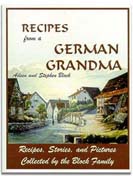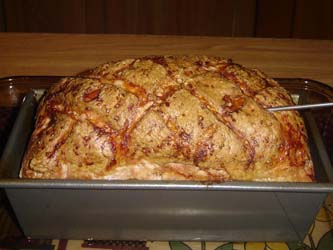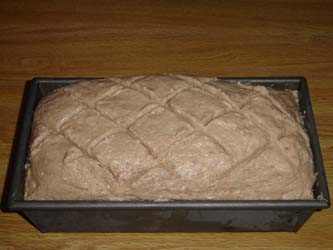 Another great Kitchen Project Recipes from a German Grandma Recipe Request German OnlineShop |
|||||||||||||||||
Join our free German Goodies Newsletter we share recipes and stories of our background Listen to German Music
Do you want to learn to speak a little German? Explore your German Heritage
|
Leberkaese
|
||||||||||||||||
|
printer friendly
|
|
Seasoning per 1kg (about 2 and 1/4 lb.) of Meat Mixture A typical loaf pan is good for a 2.5kg loaf. Seasoning per 2.5 kg ( 5 and 1/2 lbs) of Meat Mass |
|
Basic Information:
Prague #1 is used as a preservative; it also ensures that the Fleischkäse/Leberkäse has a pink color once it is cooked, vs. a gray color. The amount of Prague #1 called out is per the German stds. In Germany Pökelsalz (pickling salt) is used, this is not the same as canning salt; it is a combination of std salt and nitrite. Prague #1 is mixture of 6.255 sodium nitrite and sodium chloride. US stds call out for a much greater amount of sodium nitrite then the German stds, the amount called out in the recipe is all that is required (if well mixed and measured) per the German standards. Prague #1 is available from sausage suppliers (google Prague #1 sausage), use only Prague #1 not Prague #2, this is for dry sausage curing.
Source for Sodium Nitrite or Prague powder
Fleishkäse/Leberkäse is a “meat emulsion”, various types of meats are mixed into a homogenous mass; just like a “frankfurter”. If the meat is not processed fine enough and it does not bind it is just a “brat” if you use this for a loaf you will have an American Meatloaf. It is essential that the meat is cold for this, as well as that the appropriate amounts of fat to lean meat are present. It doesn't work correctly without fat.
Crushed Ice, this is used to help keep the meat mass cold while mixing, it also adds in the emulsion process. In a commercial butcher shop the Kutter bowls used for this process have built in refrigeration units. If you are lucky enough to have a Kutter and your freezer is large enough you can chill the bowl down ahead of time as well.
Speck
If you can't find plain fatty pork bellies, you should be able to use bacon. Keep in mind the bacon is already cured, you should adjust your salt and Prague #1 accordingly. The taste may be off a bit as well due to the cure in the bacon.
Cut the meat in strips/chucks that will fit into your meat grinder. Set the meat into the freezer to chill, for proper grinding the meat should be firm. |
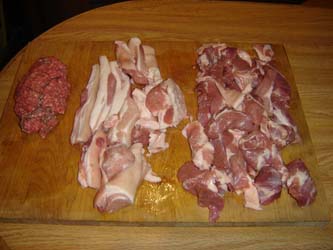 |
While the meat is chilling make your crushed ice/ice snow using your appliance of choice (I use a Cusinart), use a bit more ice then called for weight wise as some is lost in this process, put the ice in the freezer. |
 |
Weigh out the spices and set them aside. Grease the inside of your loaf pan and place it in the freezer. Note if it is no stick greasing may not be necessary. |
 |
Set up your meat grinder using the smallest grinding plate that it can handle. If you grinder is not up to it you may have to start large, chill the meat, and go smaller. Fat doesn't not grind well when warmed up. Mix the meat and run it through the grinder. |
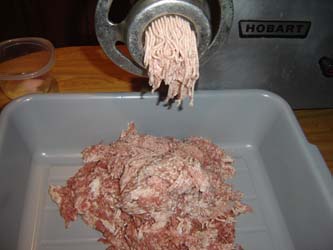 |
If you have a Kutter, add the ground meat and spices to the bowl, followed by the crushed ice. Mix until you have a homogenous mass. I mix close to 10 minutes with my Hobart Chopper, lifting the cover once to remove the meat from the mixing chamber.
If you are using a food processor, mix the spices with the ground meat, once mixed you can chop the meat mass with the crushed ice you'll have to do this in batches, keep the batches cold until you are ready to make the loaf. |
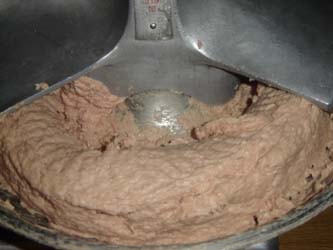 |
If this is your first time, doing this have a pot of cooking water on the stove, make a small ball of meat mass (teaspoon) and drop it into the cooking water, if it stays together it is mixed, if it falls apart it needs to be processed more. Once the meat mass is done, remove the loaf pan from the freezer and fill with the meat. A silicon spatula and water help while doing this. The meat can be domed up above the top of the loaf pan, when filled, use the wet spatula as a nice and scribe crisscrossed lines in the top of the loaf. At this point either chill the loaf for latter (quick in the freezer, then the fridge) or go to the cooking phase. |
|
Bake at 300F for 1.5-2 hours depending on the size of the loaf, the core should get to 165F. It's a good idea to place the loaf in a larger pan in case of drips.
Once out of the oven let sit for a bit, remove from pan, cut slices, and eat on German rolls, bread with mustard, and a bier. |
|
During the week have a Strammer Max (Slice of bread, Slice of Leberkäse, Sunny side up egg, topped with fried onion rings. |
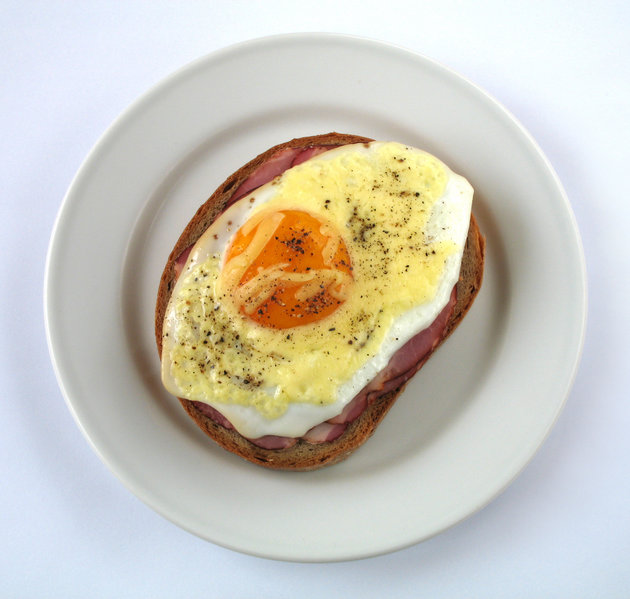 |
A
Do you have a question or comment on this recipe?
Back to top
E-Mail The Webmaster stephen@kitchenproject.com
© 1998- to present The Kitchen Project
Last updated March 4, 2009
